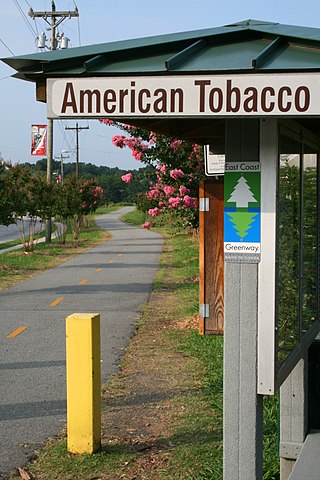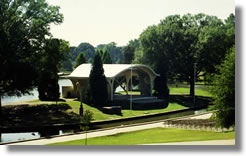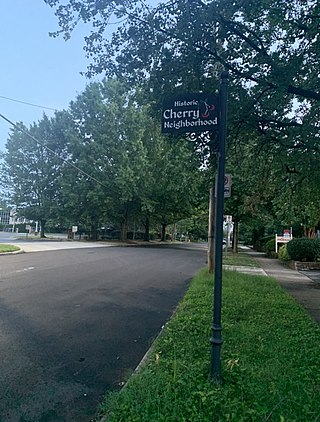
Charlotte is the most populous city in the U.S. state of North Carolina and the county seat of Mecklenburg County. The population was 874,579 at the 2020 census, making Charlotte the 15th-most populous city in the United States, the seventh-most populous city in the South, and the second-most populous city in the Southeast behind Jacksonville, Florida. The city is the cultural, economic, and transportation center of the Charlotte metropolitan area, whose estimated 2023 population of 2,805,115 ranked 22nd in the United States. Metrolina is part of an eighteen-county market region or combined statistical area with an estimated 2023 population of 3,387,115.

Mecklenburg County is a county located in the southwestern region of the U.S. state of North Carolina, in the United States. As of the 2020 census, the population was 1,115,482, making it the second-most populous county in North Carolina, and the first county in the Carolinas to surpass one million in population. Its county seat is Charlotte, the state's largest municipality.

Pineville is a suburban town in the southernmost portion of Mecklenburg County, North Carolina, United States. Part of the Charlotte metropolitan area, it is situated in the Waxhaws district between Charlotte and Fort Mill.

The American Tobacco Trail (ATT) is a 22.6-mile (36.4 km) long Rails-to-Trails project located in the Research Triangle region of North Carolina, running along an abandoned railroad bed originally built for the American Tobacco Company in the 1970s. The route crosses through portions of Durham County, Chatham County, and Wake County. The ATT is part of the East Coast Greenway and is open to pedestrians, cyclists, equestrians and other non-motorized users.

The East Coast Greenway is a 3,000-mile (4,800 km) pedestrian and bicycle route between Maine and Florida along the East Coast of the United States. The nonprofit East Coast Greenway Alliance was created in 1991 with the goal to use the entire route with off-road, shared-use paths; as of 2021, over 1,000 mi (1,600 km) of the route (35%) meets these criteria. In 2020, the Greenway received over 50 million visits.

Interstate 485 (I-485) is a 66.68-mile-long (107.31 km) auxiliary Interstate Highway encircling Charlotte, North Carolina. As a complete loop, it is primarily signed with "inner" and "outer" designations, though at some major interchanges, supplemental signage reflects the local compass orientation of the road. The entire route lies within Mecklenburg County.

The Midtown Greenway is a 5.7-mile (9.2 km) rail trail in Minneapolis, Minnesota that follows the path of an abandoned route of the Milwaukee Road railway. It is considered under segregated cycle facilities.

A greenway is usually a shared-use path along a strip of undeveloped land, in an urban or rural area, set aside for recreational use or environmental protection. Greenways are frequently created out of disused railways, canal towpaths, utility company rights of way, or derelict industrial land. Greenways can also be linear parks, and can serve as wildlife corridors. The path's surface may be paved and often serves multiple users: walkers, runners, bicyclists, skaters and hikers. A characteristic of greenways, as defined by the European Greenways Association, is "ease of passage": that is that they have "either low or zero gradient", so that they can be used by all "types of users, including mobility impaired people".

Route 4 is an 18.6-mile (29.9 km) partial ring road located in Charlotte, North Carolina. Beginning and ending at Interstate 85 (I-85), it loops south around Uptown Charlotte along state-maintained secondary roads, connecting the Charlotte Douglas International Airport and several city neighborhoods including Madison Park, Myers Park, Windsor Park and Sugar Creek. The route is posted by the Charlotte Department of Transportation (CDOT), using a modified pentagonal county road shield, with a green background and the city's crown logo above the number. The loop has a radius of about 4 miles (6.4 km), hence the number.

Freedom Park is a 98-acre park in Charlotte, North Carolina. Located at 1900 East Boulevard, between Charlotte's historic Dilworth and Myers Park neighborhoods, the park is centered on a 7-acre lake, and is about 3 miles (4.8 km) from the heart of Charlotte's downtown area.
The transportation needs for the city of Charlotte, North Carolina are served by an expanding mass transit system, major airport, and several highways.

This is a list of trails and greenways in Detroit.

An extensive collection of parks and greenways exists in Huntsville, Alabama for the public's recreational use.

Ray's Splash Planet is a Mecklenburg County, North Carolina funded water park located in Charlotte, North Carolina, United States. The aquatic facility is operated by the Mecklenburg County Park and Recreation department. Ray's Splash Planet is considered one of the largest indoor water parks in both of the Carolinas and is the largest water park in Charlotte, North Carolina, with over 29,000 square feet of space and using over 117,000 gallons of water at 87 degrees. The water is cleaned and sanitized through the use of chlorine, filtration and an ultraviolet germicidal irradiation system. There are multiple attractions including the Blue Comet, a three-story figure 8 slide, and other family friendly attractions like the Orbiter, Saturation Station, the Vortex, Meteor Showers, Moon Beach and the Sea of Tranquility. The water park also features a fitness center and gymnasium shared with the Irwin Academic Center, an educational center of the Charlotte-Mecklenburg Schools system. The first floor of the facility includes the pool area, locker rooms, birthday party classrooms and concessions stand. The second story includes the fitness center with an aerobics/dance studio. Access to the indoor gymnasium is also located on the second floor. Ray's Splash Planet is located on North Sycamore Street near Johnson & Wales University and is just off Interstate 77 in North Carolina in the Third Ward section of Uptown Charlotte. The water park opened on October 15, 2002 with help from Mecklenburg County Park and Recreation's partnership with Charlotte-Mecklenburg Schools. Major competitors are Carowinds in Charlotte, North Carolina, Great Wolf Lodge in Concord, North Carolina and Wet 'n Wild Emerald Pointe in Greensboro, North Carolina.

Midtown Park is a one acre minipark at South Kings Drive and Pearl Park Way in Charlotte, North Carolina. Opened in the spring of 2012, it contains stonework and shade trees surrounding a rectangular lawn and is suitable for weddings as well as performance art and other public events. The park features several sculptures, including a seven foot diameter spherical metallic piece called the Braille Music Box by artists Po Shu Wang and Louise Bertelsen. A unique feature of the sculpture is that it can be enjoyed by the sight-impaired. It contains a mechanism which can translate Braille letters into musical notes, and visitors can move the music box within the sculpture to hear this unique music.

Clanton Park is a 77-acre urban park at 1520 Clanton Road in the West Boulevard neighborhood of Charlotte, North Carolina. It features playgrounds, fields for soccer and softball, eleven basketball courts, picnic shelters, and a gazebo. The park also manages the nearby Clanton community pavilion, a 4,500 square foot indoor facility at 3132 Manchester Avenue. A half-mile section of the Irwin Creek Greenway runs through Clanton Park.

Thomas Polk was a planter, military officer in the Continental Army during the American Revolutionary War from 1775 to 1781, and a politician who served in the North Carolina House of Commons, North Carolina Provincial Congress, and Council of State. Polk commanded the 4th North Carolina Regiment in the Battle of Brandywine. In 1786, Polk was elected by the North Carolina General Assembly to the Congress of the Confederation, but did not attend any of its sessions. Polk was a great-uncle of the 11th President of the United States, James K. Polk.

The Lynx Blue Line is a light rail line in Charlotte, North Carolina, United States. Opened in 2007, it was the first rail line of the Charlotte Area Transit System, and the first major rapid rail service of any kind in the state. The 26-station, 19.3-mile (31.1 km) line extends from its northern terminus at the University of North Carolina at Charlotte in University City through NoDa, Uptown, and South End, then runs along South Boulevard to its southern terminus just north of Interstate 485 at the Pineville city limits. The line carries an average of over 27,700 passenger trips every day and offers connections to the CATS' CityLynx Gold Line which opened in 2015.

Cherry is a historical African-American neighborhood in Charlotte, North Carolina. Adjacent to Uptown Charlotte, it is bounded within Little Sugar Creek, Kenilworth Avenue, John Belk Freeway, East 4th Street, Queens Road, and Henley Place.
























